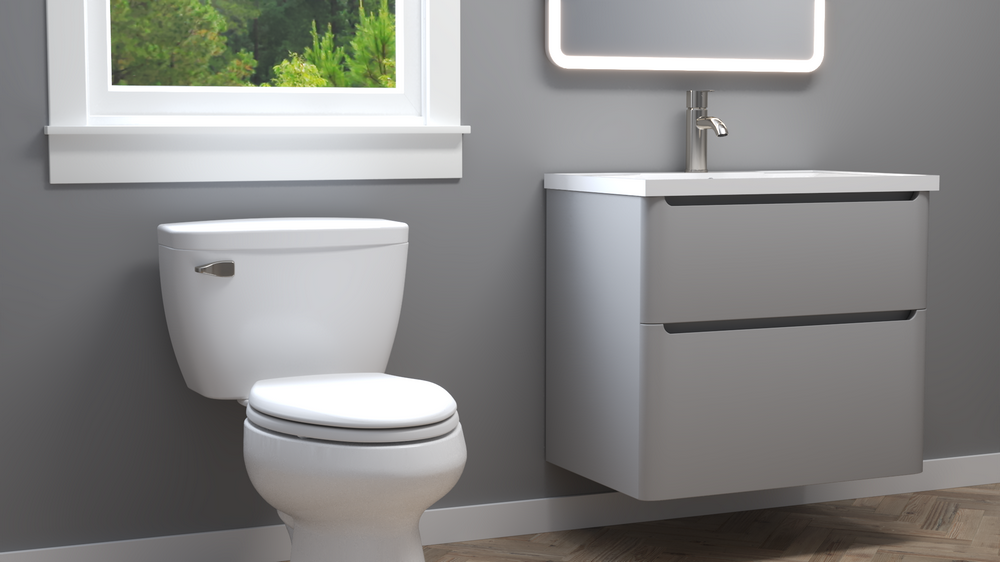Addressing Clogging Concerns
How pressure-assisted systems are providing next-level drain-line carry

By Mike Gembarski
The Energy Policy Act of 1992 changed the game for plumbing fixtures. Put in place as a national water efficiency standard for toilets, the legislation required new toilets sold to flush no more than 1.6 gallons of water per flush. However, the rule also kickstarted a national debate on drain-line transport efficacy.
Thirty years later, manufacturers have made great progress designing high-efficiency toilets that reduce water consumption levels down to 1.28 and even 1.0 gallons per flush. But these new models are once again renewing concerns among engineers about drain-line transport issues.
Those concerns, however, can be put to rest thanks to pressure-assisted systems.
A growing issue
Clogged toilets are not only a major headache for facility managers – they’re also playing a key role in customer satisfaction. According to a survey commissioned by Sofidel, 86% of Americans say a clogged public restroom toilet negatively impacts their perception of a business. And it’s not like a clogged toilet only happens every so often. Every month, 27% of Americans – people who live in apartments, stay in hotels and dine in restaurants – claim to experience at least one toilet clog, per Biard & Crockett.
When every clogged toilet negatively affects productivity and public perception, it is time to pivot to a better solution. Pressure-assisted toilets help eliminate clogs, increase drain-line carry and save water, all while offering superior performance.
Pressure-assisted toilets use pressure (as opposed to gravity) to generate a longer drain-line carry, pushing waste up to 50% further than the recommendation set by the American Standards Institute. This increased performance helps facilities see fewer clogs and keeps customers happy, while saving water and meeting important sustainability requirements in the process.
The force is strong
Gravity toilets are the most common type of toilet. As their name implies, gravity-type toilets use gravity to pull waste from the bowl. When the handle is pressed, a valve opens in the tank, and the water enters the bowl. As the water enters the bowl, a majority of the water is used to create a siphoning effect that pulls waste out of the bowl, leaving less water behind the waste to push it down the pipe. Except when it doesn’t – and you get a clog.
The process used by pressure-assisted toilets is straightforward: a pressure-assist vessel is installed inside the toilet tank that uses the water supply line pressure to compress the trapped air in the vessel. When the pressure-assist vessel’s internal pressure reaches a certain threshold, the toilet is ready to flush. When flushed, the compressed air expands, pushing the water through the toilet at up to 70 gallons per minute, more than twice the rate of a traditional gravity system, and the whole flush cycle takes less than five seconds.
Instead of the pulling or siphon action of an ordinary gravity toilet, the pressure-assisted unit pushes waste out. This powerful flushing action enables fewer double flushes by clearing the bowl on the first flush — not to mention how much wasted water it eliminates.
That extra power is how toilets equipped with pressure-assisted systems maximize water delivery force to clear the bowl with a single flush. It’s also why a pressure-assisted toilet is far less likely to clog.
The choice is clear
Pressure-assisted toilets make sense in almost any commercial setting, as well as residential construction. The more toilets you manage, the more sense they make.
The benefits of pressure-assisted systems don’t stop at drain-line carry. Fewer moving parts and reduced leaks make upkeep simple. Toilets also stay cleaner longer thanks to the larger water surface in the bowl and powerful flushing action. Pressure-assisted toilet tanks have less condensation, helping to keep the floor dry. In addition, reduced water usage and fewer maintenance and service calls can save facilities and homes valuable time and costs.
Make a pressure-assisted toilet part of your next toilet install, and you may never have to deal with the messy, expensive nuisance of clogged toilets again.
Mike Gembarski is Flushmate’s senior product line manager.

